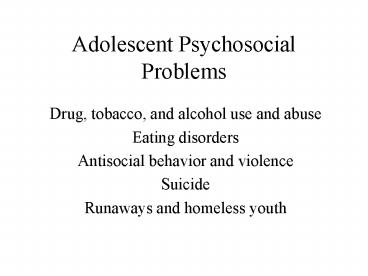Adolescent Psychosocial Problems - PowerPoint PPT Presentation
1 / 13
Title:
Adolescent Psychosocial Problems
Description:
80% of high school seniors have used alcohol. Most do not become problem drinkers. ... Exposure to violence in TV and video games. ... – PowerPoint PPT presentation
Number of Views:1290
Avg rating:3.0/5.0
Title: Adolescent Psychosocial Problems
1
Adolescent Psychosocial Problems
- Drug, tobacco, and alcohol use and abuse
- Eating disorders
- Antisocial behavior and violence
- Suicide
- Runaways and homeless youth
2
Some principles...
- Distinguish between occasional experimentation
and enduring patterns of dangerous behavior. - Distinguish between problems having origins and
onset during adolescence and those having roots
in earlier periods of development. - Many adolescent problems are brief and are
resolved by early adulthood. - Problem behavior during adolescence not a direct
consequence of the normative changes of
adolescence.
3
Adolescent drug use and abuse
- Monitoring the Future annual survey
- http//monitoringthefuture.org
- Risk factors
- psychological
- conflicted family relationships
- social
- social context
4
Protective factors include...
- Positive mental health (e.g., high self-esteem)
- High academic achievement
- Close family relationships
- Involvement in religious activities
5
Tobacco use
- 33 of 12-17 year olds have tried tobacco.
- Most teens who smoke began before high school
years. - Antismoking education is critical in elementary
and middle school. - Contributing factors include advertising, adult
models, peer pressure, need for status.
6
Alcohol use and abuse
- Most adolescents have experimented with alcohol.
- 80 of high school seniors have used alcohol.
- Most do not become problem drinkers.
- Chronic drinking may be genetic or may be modeled
by parents who drink heavily.
7
Risk factors
- Family history
- Religiosity
- SES
- Place of residence
- Social relationships
- Peers uses
- Juvenile delinquency
- Loneliness
- TV viewing
- Parental support
- Deviant behavior
- Other family-related risk factors
8
Social norms approach
- http//www.socialnorm.org
- The National Social Norms Research Center (NIU)
9
Eating disorders
- Dieting
- Anorexia nervosa
- Bulimia (binging and purging)
- Obesity
10
Antisocial behavior and violence
- Legacy of Columbine High School.
- Exposure to violence in TV and video games.
- Adolescents two-and-a-half times more likely to
be victims of crime. - Homicide second leading cause of death.
11
Suicide
- warning signs
- Sudden, unexplained changes in behavior
- Changes in sleeping or eating patterns
- Loss of interest in usual activities
- Social withdrawal
- Experiencing a humiliating event
- Feelings of guilt or hopelessness
- Inability to concentrate
- Talking about suicide
- Giving away important possessions
12
Risk factors
- Mental illness and/or biochemical imbalances
- Substance abuse
- Stresses and chaotic family life
- The availability of lethal means (handgun in the
home) - Prior suicide attempts
13
Runaways and homeless youth
- Provide care and support
- Provide additional academic assistance, as needed
- Provide support for runaway youth organizations
and shelters - Work with social workers and family services
- Encourage peer acceptance

